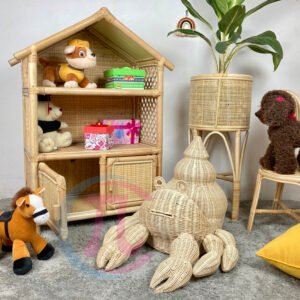In 1994, Indonesia became the largest rattan-producing country in the world because it was able to supply this product in large quantities by owning 56% of all types of rattan in the world or around 306 species. According to Subraja (1997) in Pramudiarto (2006), Indonesia’s rattan production potential at that time reached around 600 thousand tons per year from a rattan forest area of 10 million hectares spread throughout the archipelago, especially Kalimantan, Sumatra and Sulawesi.
Rattan is known as a plant that grows vines or climbs on large trees as a support. This is due to the presence of rattan climbing tendrils that appear and grow from the segments of the stems of this plant with varying lengths. Some rattans do not have tendrils, but have spines along their stems that help the rattan to climb or propagate.
The stem itself is round or elongated triangle whose length can reach tens of meters. The length and diameter varies greatly depending on the species. The stems of this plant are segmented and bordered by books. The stem of this plant is the part that is most often used and has high economic value.
Based on the way the stem grows, this plant can be grouped into two parts, namely growing solitary / single and growing in clumps. Plants that grow solitary are only harvested once and cannot regenerate from a cut stump, while those that grow in clumps can regenerate and grow continuously. Clumps are formed by the development of shoots produced from axillary buds at the bottom of the stem.
On the stem there are compound leaves and leaf midribs that grow to cover the segments of the stem. The length, width, and shape of the leaves also vary greatly depending on the species. As is the case with other plants, the leaves have a photosynthetic function. In addition, the leaves also have small thorns as a form of self-defense. These leaves generally grow facing inward as reinforcement to attach the stem to the supporting plant or host.
This plant includes compound flowering plants that are wrapped in a sheath. Male flowers and female flowers generally have one house, but there are several types of rattan whose flowers have two houses. In two-flowered flowers, pollination is assisted by insects or wind. The flowers are relatively small and have 3 pistils on the female flowers, while the male flowers have 5 stamens. This plant also has fruit that is round, oval, or oval. The fruit has trapezoidal fruit scales and is arranged vertically from the toxic fruit.
The root system of rattan is in the form of a fibrous root system. The color of the roots also varies from grayish white, yellowish to blackish.
Taxonomy
Criteria Description
Kingdom Plantae
Subkingdom Viridiplantae
Spermatophyta Division
Sub Division Angiosperms
Magnoliopsida class
Order of Palmales
reference : https://foresteract.com/rotan/

0 Comments